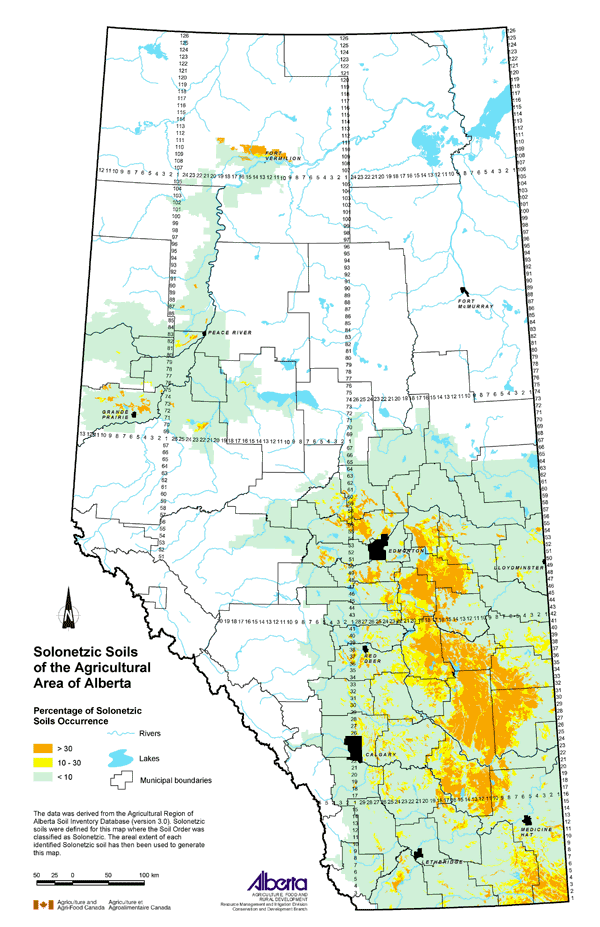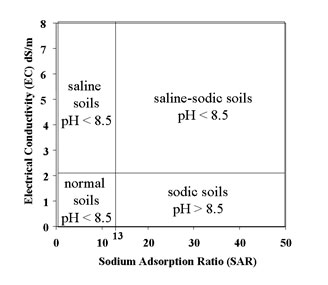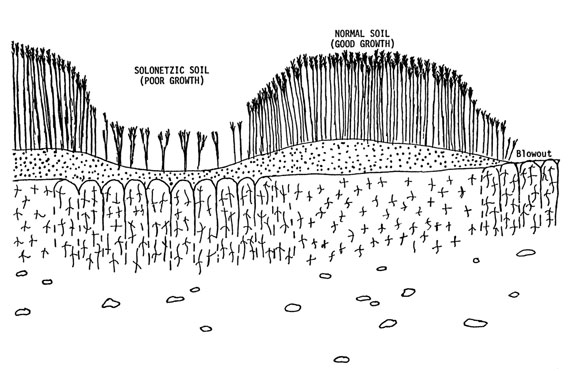| | Characteristics of a sodic soil | Diagnosing saline and sodic soils | Sodic soil structure | Management of sodic soils
The two main types of salt-affected soils found in Alberta are saline soils and sodic soils.
Saline soils are soils with a high enough concentration of soluble salts to impair crop growth. Sodic soils have a high level of exchangeable sodium (Na+), low levels of soluble salts and have a negative effect on crop growth and yield. Soils with a high level of both soluble salts and sodium are referred to as saline-sodic soils.
Characteristics of a Sodic Soil
The common characteristics of sodic soils include the following:
- soil physical structure is generally very poor with a hard, cloddy structure
- sodium level in soil at a high enough concentration to cause nutrient imbalances or toxicity to sensitive plants
- soil pH is usually high, often greater than 8.4
Most sodic soils in Alberta are classified in the Solonetzic soil order. Figure 1 shows the regions of Solonetzic soils in Alberta. Solonetzic soils are found in both grassland or grassland-forest transition regions and have a high sodium content that occurs naturally in the surface soil or is drawn from the sub-soil to the soil surface by groundwater flow.

Figure 1. Occurrence of Solonetzic soils in Alberta
Diagnosing Saline and Sodic Soils
To clearly establish if a soil is saline or sodic, laboratory chemical soil tests are required. The first step in testing is to take a composite sample of about 15 soil cores at0 to 6, 6 to 12 and 12 to 24 inches in depth (0-15, 15-30 and 30-60 cm) from the affected area. Also take soil samples from an unaffected adjacent area for comparison to assist with diagnosing the problem soil. Send the soil samples to an accredited laboratory, following their procedures for handling and shipping.
The laboratory will run a series of tests. One of the tests, the Electrical Conductivity (EC) soil test, is used to determine the level of soluble salts in a soil, which will indicate if a soil is saline. The EC of a soil is determined by saturating a soil sample with distilled water to form a saturated paste; then, the excess water is extracted. The amount of electrical current the extract will conduct indicates the level of soluble salts.
EC is given in units of decisiemens per metre (dS/m). Table 1 provides the classification levels of saline soils. (For more information on saline soils, refer to the list of Agdex documents or websites listed at the end of this publication.)
Table 1. Salinity rating and electrical conductivity value
| Soil depth | Non-saline | Weakly
saline | Moderately
saline | Strongly
saline | Very strongly
saline |
| 0-60 cm (0-2 ft) | <2 dS/m | 2-4 dS/m | 4-8 dS/m | 8-16 dS/m | >16 dS/m |
| 60-120 cm (2-4 ft) | <4 dS/m | 4-8 dS/m | 8-16 dS/m | 16-24 dS/m | >24 dS/m |
The Sodium Adsorption Ratio (SAR) is the laboratory soil test commonly used to determine the sodium level in soil. SAR is the ratio of the concentration of sodium cations in soil compared to the combined concentration of calcium (Ca++) and magnesium (Mg++) cations in soil. The formula used to calculate SAR is as follows:

Figure 2. Classes of salt-affected soils
The concentration values for Na+, Ca++ and Mg++ used in the formula are in millequivalents per litre (meq/L).
The SAR level of soil is determined by saturating a soil sample with distilled water to form a saturated soil paste. Then, the excess water is extracted and analyzed to determine the concentration of sodium, calcium and magnesium levels in the extract to then calculate the SAR.
A soil SAR value below 2 is most desirable. A soil SAR level above 13 is considered very high, and the soil is classified as sodic (Figure 2). It is important to note, however, that sodium can potentially cause soil structure deterioration and water infiltration problems at SAR values as low as 5 to 6.

Figure 2. Classes of salt-affected soils
The Exchangeable Sodium Percentage (ESP) is used by some labs to determine sodium levels in soil. An ESP of more than 15 per cent is considered the value for a soil classified as sodic, indicating that sodium occupies more than 15 per cent of the soil cation exchange capacity (CEC). However, sensitive plants can show toxicity injury or poor growth at lower levels of exchangeable sodium.
The sodium status of soils is usually inferred from lab measurements of the soil solution (SAR of saturation extract) since this is a simpler procedure, which is less subject to errors inherent in the determination of CEC and exchangeable cations, especially in calcareous soils.
Sodic Soil Structure
Solonetzic soils are characterized by a high level of sodium in the B soil horizon (layer of soil below the top soil or A horizon) (see Figure 3). The B horizon may also have an accumulation of clay leached down from the A horizon into the B horizon.
The presence of a sodium-enriched B soil horizon causes unique physical and chemical characteristics that cause agronomic problems for crop production:
- poor physical soil structure that reduces crop emergence, root growth and water infiltration
- toxic levels of sodium in the soil that reduce plant growth
- high soil pH
- result of these problems is reduced plant growthand yield
The poor, cloddy soil structure is caused by the high levels of sodium in the soil. The poor structure occurs when positively charged sodium ions are unable to satisfy the negative charge of clay particles. This situation results in dispersion or repelling of clay particles when soils are wet. This process is called “deflocculation” of soil particles.
When the soil dries, the result is a very hard, massive, cloddy soil with a columnar structure (Figure 3). The poor soil structure makes cultivation or seeding operations very difficult. These soils tend to crust after precipitation resulting in reduced crop emergence.
The hard B soil horizon will restrict root growth and penetration (Figure 3). Reduced crop emergence and root penetration will reduce crop growth and production. (For more information on Solonetzic soils, refer to these Agdex publications.)
Sodic soils often have a relatively high clay content (> 30%). When soils are wet, they tend to seal up as a result of the deflocculation process, causing very slow water infiltration into soil.
Reduced water infiltration is caused by the dispersion of clay particles and reduced soil pore size, which can lead to water runoff and soil erosion problems with sloping soils. When runoff occurs, the amount of water stored in the soil is reduced, which further limits crop yield potential.
The increased sodium level causes soil pH to be very high, often above 8.4. A soil pH above 8.4 often indicates a sodic soil problem. A soil with a high pH is correctly referred to as “alkaline.”
However, the term “alkali” is often incorrectly used to describe surface soils that appear white and are high in soluble salts. Soils high in soluble salts are correctly referred to as saline soils (Figure 2).
The term “black alkali” is sometimes used to refer to sodic soils. Sodic soil clods may have a somewhat black sheen or appearance caused by a coating of sodium enriched organic matter.

Figure 3. Solonetzic soil with columnar-structured B horizon, which restricts water and root penetration into sub-soil
Management of Sodic Soils
Solonetzic soils in the Brown or Dark Brown soil zones in Alberta that are in native grassland may be best left in their native condition and used for carefully managed livestock grazing. If improvement or reclamation of Solonetzic soil is considered, refer to Agdex 518-8 Management of Solonetzic Soils available online at Alberta Agriculture and Rural Development’s website:
Sodic soils have limited crop production potential. The relatively high sodium and pH levels restrict the growth and yield potential of most annual crops and even a number of forage crops. Farmers with sodic soils are faced with decisions on how to best manage their land.
Unfortunately, the options are limited:
- If land is in native grassland, leave in the native state and utilize for livestock grazing.
- Grow a more sodium-tolerant crop.
- Modify the soil condition with an amendment.
Leave in native state: In many situations, sodic soils are best left in the native state and utilized for carefully managed livestock grazing.
Sodium-tolerant crops: Grow crops that are tolerant to sodium. The most tolerant annual crop to sodium is barley, and crops with moderate sodium tolerance are wheat, oat and rye. However, none of these crops will be very productive at SAR levels above 12. The crops most sensitive to sodium toxicity are pulse crops, including pea, lentil and dry bean; therefore, these crops should not be grown on soils with moderate to high levels of sodium.
A better option is to establish a sodium-tolerant forage mixture. The most sodium-tolerant forage crops include various wheat grasses and alfalfa. Fescue grasses have moderate sodium tolerance. Soils that have high levels of sodium are probably best seeded to a tolerant grass mixture and used for livestock grazing or, as mentioned, if in native vegetation, left in their native state.
Reclamation of sodic soils: Reclamation or improvement of sodic soils can be very expensive, and improvement will take time. Reclamation involves careful soil sampling and analysis to determine the severity of the problem and then calculating how much calcium must be added to the soil. Often, several tons of a calcium product must be applied and well incorporated into the soil to modify the sodic condition.
To improve a sodic soil, most of the exchangeable sodium must be removed by leaching it downward, below the root zone. To accomplish this result, the sodium in the soil exchange complex must be replaced by calcium.
If free lime (calcium hydroxide) is present in the soil (determined by a soil test), applying elemental sulfur will reduce the soil pH, which will also dissolve the lime that naturally occurs in the soil, to free up the calcium.
If free lime is not present in the soil, calcium must be added with application of a chemical soil amendment. Soil amendments are calcium-containing materials such as gypsum (calcium sulphate) or calcium chloride, which can supply soluble calcium to replace the exchangeable sodium.
The calcium amendment is normally broadcast onto the soil surface, followed by thorough incorporation with cultivation. Then, adequate moisture is necessary to dissolve the calcium to initiate the displacement of sodium from the soil exchange complex.
It takes considerable time for natural precipitation to leach the sodium from the root zone. In drier climatic regions of the province, this process could take a number of years and may not be completely successful. However, greater success can result with the application of significant amounts of good quality irrigation water to leach the sodium from the root zone over a period of years.
Additional organic matter such as straw, livestock manure or green manures will help to improve the physical soil condition (e.g. tilth and water infiltration). However, care must be taken to ensure that any material added to the soil (e.g. manure) does not contain sodium. It is important to note that sodic soil reclamation is a relatively slow process.
The amount of a chemical amendment used to replace the exchangeable sodium in soil will depend on the amount of sodium in the soil, the desired level of soil improvement, the type of amendment used and the volume of soil to be reclaimed.
Gypsum is a commonly used amendment because it is inexpensive, reasonably soluble and more readily available. The following detailed formula can be used to determine the amount of pure gypsum required to amend a sodic soil:
MPG = db x A x D x (ESPA – ESPD) x CEC x (8.6 x 10-7)
In this formula:
- MPG is the mass of pure gypsum, in megagrams (Mg) or metric tonnes, required to amend the stipulated volume of soil.
- db is the bulk density of the soil, given in units of kg/m3.
- A is the area stipulated in m2 (1 hectare equals10,000 m2.)
- D is the depth of soil to be amended, in metres.
- ESPA is the actual Exchangeable Sodium Percentage of the soil to be amended, expressed as a decimal value (e.g. 20% would be entered as 0.20).
- ESPD is the desired Exchangeable Sodium Percentage of the soil, expressed as a decimal value.
- CEC is the cation exchange capacity of the soil, in units of milliequivalents per 100 grams (meq/100 g).
- The remaining numbers are conversion factors for the atomic mass of pure gypsum.
The following are simplifications of the formula, in metric and imperial units.
MPG(in Mg per hectare to a depth of 30 cm) = (ESPA – ESPD) x CEC x 3.5
In this case, the bulk density (db) is estimated to be 1,350 kg/m3, the area is 10,000 m2 and the depth is 0.3 m. The values required from soil lab analysis are the actual ESP (ESPA) and CEC of the top 30 cm of soil.
MPG(in tons per acre to a depth of 1 foot) = ESPA – EXPD) x CEC x 1.6
In this case, the mass of gypsum required is given in tons per acre to amend soil to a depth of one foot. The values required from lab analysis are still in units of decimal per cent for ESP and meq/100 g for CEC.
The desired ESP (ESPD) should be determined by the producer, based on the type of crops to be grown on the site. Note that this estimation is for pure gypsum and that gypsum available for purchase may contain impurities.For this reason and because of inefficiencies in the calcium-sodium exchange process, the actual amount of amendment used may have to be increased by 20 to30 per cent.
Other calcium-containing amendments can be used to amend sodic soils. Calcium chloride, for example, can be another economical amendment, which has a higher solubility than gypsum but may not be as readily available. Calcium carbonate is of limited use as an amendment for sodic soil as it has a low solubility.
Regardless of which type of amendment is used, the landowner should work with the supplier and a qualified agrologist with a specialty in soil science to determine the suitable application rate.
Once the amendment has been applied to the surface, it must be thoroughly mixed into the soil by cultivation. The soil must be moist to hasten the exchange process. The sodium must then be leached down the soil profile by rainfall or by the application of good quality irrigation water. Short, frequent irrigations will give the best results.
If a sub-surface hard pan layer is preventing internal drainage of the soil, it may have to be deep-ripped to allow the sodium to be flushed below the root zone. If the site can be cropped during the process, better results will be achieved due to enhanced soil permeability resulting from the growth of plant roots.
The installation of a sub-surface drainage system may be necessary to permanently move the sodium salts away from crop roots; however, drainage systems are expensive and safe disposal of the high sodium drainage water is essential. Alberta Environment must be contacted prior to installation of a subsurface drainage system to determine if approval and licensing of the drainage system will be required.
As stated, the amendment of sodic soils can be a long and laborious process and is not always successful or permanent. For example, over-irrigation or the occurrence of a large rainfall event can cause the water table to rise, bringing the sodium salts back to the soil surface, leading to deflocculation of the surface soil. Therefore, the management of a sodic soil must be considered as an ongoing process.
It is important to note that calcium-containing amendments should never be added to saline or saline-sodic soils because this will only increase the amount of soluble salts in the soil and worsen the salinity problem.
Summary
Sodic soils have relatively high sodium levels. In many situations, sodic soils are best left in the native state or seeded to a tolerant forage crop. Often, the highest agricultural use of sodic soils is for carefully managed livestock grazing.
If reclamation is considered, it is recommended that producers work with a knowledgeable agrologist with expertise in soil science and salt-affected soils. The first step to improving management is to correctly diagnose the soil problem by proper intensive soil sampling and analysis.
If sodic soil conditions are diagnosed and reclamation is considered, a detailed soil analysis is needed for electrical conductivity, sodium adsorption ratio, exchangeable sodium, free lime, soil pH and cation exchange capacity.
For information on Solonetzic soils refer to Agdex 518-8, available online at Alberta Agriculture and Rural Development:
Considerable information on saline soils is available online at the Alberta Agriculture Ropin’ the Web site:
Prepared by
Dr. Ross H. McKenzie P. Ag.
Research Scientist – AgronomyAgriculture Research Division
Alberta Agriculture and Rural Development
Lethbridge, AB
Phone: 403-381-5842
Dr. Shelley A. Woods P. Ag.
Research Scientist – Soil and WaterIrrigation and Farm Water Division
Alberta Agriculture and Rural Development
Lethbridge, AB
Phone: 403-381-5839
More information
Alberta Ag-Info Centre
Call toll-free 310-FARM (3276)
Source: Agdex 518-20. June 2010. |
|